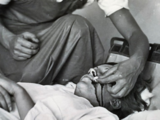UK cave expert explains the keys to risky Thailand rescue

Two British cave divers were the first this week to reach the 12 missing boys and their soccer coach trapped in the flooded Tham Luang cave complex in Thailand.
"How many of you?" asked John Volanthen, an IT consultant.
"Thirteen? Brilliant."
Volanthen and Richard Stanton, a retired firefighter, are volunteers with the British Cave Rescue Council (BCRC), a group that coordinates voluntary underground rescue efforts. They arrived in Thailand three days after the soccer team went missing, part of an international effort involving volunteers from around the world.
Bill Whitehouse, vice chairman of the BCRC, spoke to Univision News from his home in the Peak district in Derbyshire, England.
How soon can the boys and their coach be rescued?
Bill Whitehouse: “I’m not sure about that. The rescuers have been looking at all sorts of things. When the two (UK) divers got through to them they had to get through about 1.5 kms of flooded passage but not all that was without airspace, about 50-50, I gather. Whether with the lack of rain the situation has improved somewhat, it may have done.
A lot of the water levels have gone down from the peak last week, but a lot of the passage is still flooded. They have been pumping (out) a lot of water. Whether the pumping has had much of an effect on the water levels or whether the lack of rain has had an effect, or a combination of the two, we can’t really know.
When our guys first got there serious diving wasn’t really possible because of the fast flow of the water. The amount of suspended sediment in the water meant the visibility was less than one meter probably. It was only last weekend, when the weather lifted a bit and the rain stopped. The water will find its way through and subside if it’s not being replenished from outside all the time. So, it’s impossible to say how much the pumping has helped.
What kind of gear will the rescue divers need?
BW: “It depends on whether the airspace is big enough to actually float in or whether it’s only a couple of inches. It might be a mixture. I have no detailed knowledge of that. In all probability, it’s a mixture of the lot. Supposing you’ve gone through a completely flooded area and you come into an area that’s completely flooded, if you are in diving gear and you only have a few yards to go before the next flooded bit, then you might as well keep on diving. Then the next one will be something completely different.”
Normal scuba divers will wear their tanks on their back. Cave divers normally in constricted passages will side mount the tank so that they can get through things that way without removing the tanks.
Lots of skilled divers use a mask over their eyes and a clip on their nose and a gag (regulator) in their mouth which is giving them their air supply. If you are bringing a casualty back through a flooded passage, or somebody who is not a diver you are much better using a full-face mask of one sort or another because they aren’t having to worry about keeping a gag in the mouth or anything like that because the air is introduced into the mask. These masks also have a positive pressure bleeding air out into the mask all the time. So, that keeps the water from flooding the mask, unless of course the mask is dislodged, which is always a danger.
Could the children be rescued with scuba gear?
BW: It will depend on how the child is prepared. You can go to one extreme of the child swimming out with scuba gear on and being guided. That would be very dangerous because some of the children can’t swim, and they haven’t done this sort of thing before. They will be in horrendous conditions, and with the visibility in the water they might not be able to see the person in front of them who is trying to help them, who might not be able to be alongside them. There is a chance of one of them panicking and dislodging their breathing apparatus. In the other extreme, you could turn the child into an inert parcel by wrapping them up without making them bigger, fitting them with an air supply and a full-face mask, and possibly sedating them. And then weighting them so they are neutrally buoyant so that they will float without floating up and being jammed against the roof. You can see that happening in still water, of course in flowing water it’s another matter.
Is there another way out?
BW: One of the big exercises they have been going through is trying to find another way into the cave. There is only one known entrance., the big one that is normally used. That’s not to say there isn’t another entrance.
But, there may be lots of small caves in the area that don’t connect to this one at all. It’s a valid exercise in the circumstances to scour the hillsides to look for shafts and entrances that might get into the cave. Though bear in mind the cave goes under a mountain. When you are above the cave there’s about 800 meters of rock or so before you get down to the level the cave is in. So, you might find a hole up at that level, but how far down it goes and whether it actually goes into the cave or in a completely different direction, or whether it goes down to the cave and gets into part of the cave that’s any use, or that’s already flooded.
Could they use rope or a static line to get out?
Whenever a cave diver goes into a flooded passage what they will do on the way in is they will lay a guideline. That’s usually a fairly thin line and it’s not a line to pull on, it’s line to use as a guide to keep them on course when there is poor visibility because you can completely use your orientation in the dark. Whether anything stouter than that has been put into the cave I don’t know if that’s the case or not.
How well mapped is the cave?
The cave was surveyed by a mixture of British and French cavers, but it’s not very accurate. It shows what direction the passages go and more-or-less what size they are, but it’s fairly small scale. There isn’t an elevation, a cross-section down through the hill, to show you how the cave varies in levels. There are cross-sections of the cave at various points. So, yes there is information, but many caves have much better information.
There is a survey that shows the plan and the series of cross sections taken at intervals, what there isn’t is a longitudinal section through the whole cave, showing how it goes up and down. The plan is drawn on quite small scale so it’s hard to tell how tall and wide the cave is along its entire passage. In certain places, the cave comes down to only a couple of feet square.
Why are their reports of air being pumped into the cave?
I suppose the idea is that if you pump air into the cave you increase the air pressure it might force the water out. I can see the theory. The problem is that caves aren’t usually very nice airtight containers. You think you are in a cave with no other way in but you’ll find the air gets out of all sorts of holes. I can see them thinking about that. There may also be a concern about oxygen levels and CO2 build up. It depends very much on the cave. Low oxygen levels are not at all unusual. If you are working in a confined space in a cave you are exhaling CO2 all the time and if the ambient air is not being replaced the CO2 levels will build up.
Who are the UK cave rescuers?
Everybody involved in cave rescue is a volunteer. Their hobby is caving and cave diving. That’s how they pick up their skills. Cavers realize if anything happens to them underground it’s going to be other cavers who are going to help them. If you do it long enough you will find yourself being encouraged or cajoled into joining a cave rescue team to serve the area where you live. And these guys are no different. In the UK there are 15 independent rescue teams.
There has been a British caver onsite right since the word go since the beginning because he lives there. It was through him talking to the authorities in the early days that the word got back to this country.



